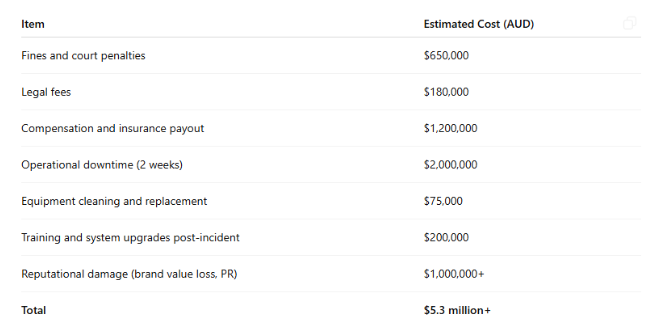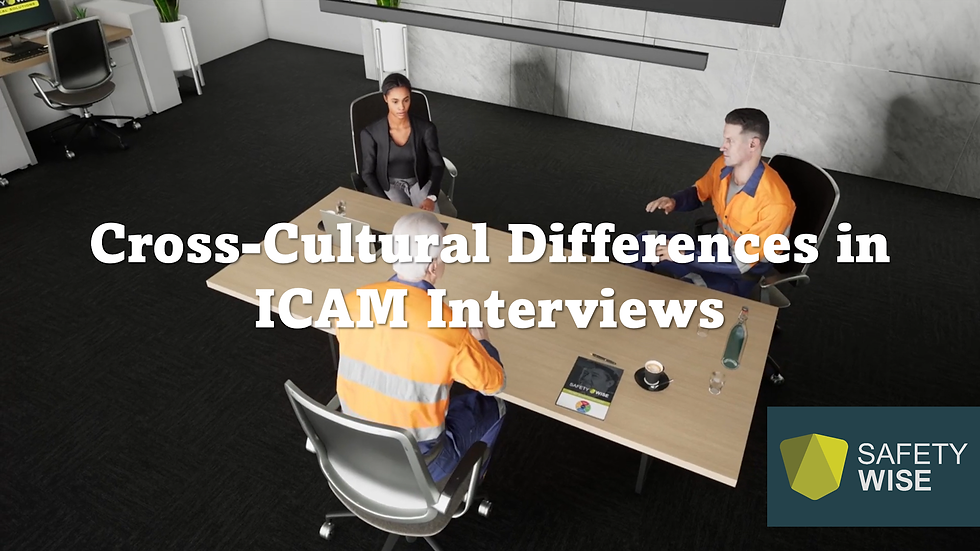Understanding the Costs Associated with Confined Space Incidents
- Luke Dam
- Jul 22
- 4 min read

Confined space work is inherently high-risk—and when incidents occur, the costs can be catastrophic. The financial toll is not limited to fines and compensation payments.
Organisations also face indirect costs such as productivity losses, legal costs, equipment damage, and long-term reputational harm. This article explores the full spectrum of costs associated with confined space incidents, why prevention is not only safer but smarter, and how businesses can make a compelling financial case for investment in confined space safety.
1. Types of Incidents in Confined Spaces
Confined space incidents often involve:
Atmospheric hazards (e.g. oxygen deficiency, toxic gases)
Physical hazards (e.g. engulfment, falls, machinery)
Heat stress and exhaustion
Inadequate rescue planning
Tragically, many confined space deaths also involve would-be rescuers—workers who enter without proper equipment or training.
2. Direct Costs of Confined Space Incidents
2A. Medical Expenses and Workers' Compensation
When an injury or fatality occurs, employers may be liable for:
Emergency medical response
Hospitalisation and ongoing treatment
Long-term care or disability compensation
Death benefits to dependents
In Australia, workers' compensation premiums may significantly increase following an incident, particularly if there is evidence of negligence or systemic failure.
➡️ Reference: Safe Work Australia – Workers’ Compensation Statistics
2B. Fines and Penalties
Work health and safety breaches involving confined spaces can attract severe fines. In Australia:
Corporations can face up to $3 million in penalties under the Model WHS Act.
Individuals such as officers or workers may face fines and even imprisonment (up to 5 years) for recklessness.
DIC Australia and Buddco (2017) – In 2017, a contractor named Craig Tanner died while cleaning an ink holding tank at DIC Australia's Auburn site. DIC was fined $450,000, and its contractor, Buddco, was fined $600,000 for failing to ensure the tank's agitator was electrically isolated, leading to the fatality. This incident underscores the critical importance of proper safety procedures in confined spaces.
2C. Equipment Damage or Contamination
Confined space incidents may result in:
Machinery damage due to fire or explosion
Contaminated tools or PPE requiring disposal
Downtime in critical infrastructure
These material losses, while sometimes minor compared to human costs, can escalate depending on the nature of the worksite (e.g., energy, water, or chemical plants).
3. Indirect Costs – The Hidden Financial Toll
3A. Operational Downtime
A single incident can halt operations for hours, days, or even weeks while investigations are conducted. For industries reliant on continuous operation (e.g., manufacturing, water treatment, oil and gas), this can equate to millions in lost revenue.
Example: A shutdown of a chemical plant due to a confined space fatality can cost $500,000 to $1 million per day in lost production.
3B. Investigation and Legal Fees
Incidents trigger investigations by:
Internal safety teams
Regulators (e.g. WorkSafe)
Police (if criminal negligence is suspected)
Legal representation, court proceedings, expert witnesses, and consultant fees quickly accumulate. Even if no prosecution occurs, a business may spend $50,000–$250,000 navigating the legal process.
3C. Increased Insurance Premiums
Insurers assess risk based on incident history. One serious confined space event can raise:
Workers compensation premiums
General liability insurance
Directors and officers (D&O) insurance
This increase may persist for 5–10 years, affecting the total cost of ownership in operations.
4. Reputational Damage and Shareholder Impact
4A. Brand and Public Image
When a confined space incident hits the headlines, public sentiment often turns against the organisation. Companies may face:
Customer loss
Investor divestment
Employee resignations
Boycotts or activist pressure
4B. Recruitment and Retention
In high-risk industries, attracting and retaining skilled workers becomes harder after a publicised safety failure. Potential employees may:
Decline job offers
Demand higher pay to offset perceived risk
Feel unsafe or unsupported
This contributes to higher turnover and recruitment costs, particularly in sectors like mining, utilities, and infrastructure.
5. Human Costs: The Unquantifiable Impact
Though this article focuses on financial implications, the personal cost of confined space incidents is immeasurable:
Families shattered by loss
Survivors facing PTSD or lifelong disability
Rescuers traumatised by their experience
No dollar figure can adequately reflect these impacts, but compassionate leadership must consider them alongside spreadsheets and budgets.
6. Case Study: Confined Space Tragedy and Cost Breakdown
Incident Summary
In 2010, two workers died and a third was seriously injured while cleaning a tank at a food processing plant. The tank contained a buildup of carbon dioxide, which displaced oxygen. The company failed to:
Conduct atmospheric testing
Provide appropriate PPE
Develop an emergency rescue plan
Financial Breakdown (Estimated):

7. The Business Case for Prevention
It’s easy to view safety investments as overhead, but in reality, proactive safety is one of the most cost-effective strategies an organisation can adopt.
7A. Cost of Prevention vs. Cost of Incident

8. Key Strategies to Avoid Confined Space Incidents
1. Risk Assessments
Identify hazards before entry
Use atmospheric testing
Consider the elimination/substitution of confined space work where possible
2. Permit to Work Systems
Ensure only trained, authorised personnel enter
Include supervisor sign-off, hazard control, and rescue plans
3. PPE and Equipment
Use calibrated gas monitors, escape sets, and harnesses
Check and maintain all safety gear regularly
4. Training and Drills
Train for entry, rescue, and emergency procedures
Conduct regular simulated rescue exercises
5. Third-Party Audits
Engage confined space safety consultants to assess systems
Verify compliance with AS 2865:2009 – Confined Spaces
➡️ Reference: Standards Australia – AS 2865 Confined Spaces
9. Final Thoughts
Confined space incidents are not just tragic—they are expensive, preventable, and indicative of wider organisational failures. While businesses often hesitate to invest in safety due to perceived costs, the aftermath of an incident proves far more costly.
By understanding the true costs, human, financial, operational, and reputational, leaders can make informed decisions that protect both people and profits. Prevention isn’t just the ethical choice. It’s also the smart one.




Comments